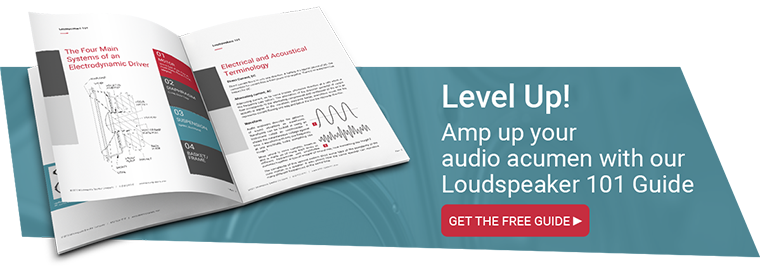Guide To Audio Acronyms for Speaker Design
The audio industry is filled with acronyms. Some are unique to designing, creating, and testing loudspeakers, and only get used regularly by people who do this work.
This helpful list can provide you with the information you need when you’re having conversations with others in the speaker industry.
BL
Motor strength of the speaker as expressed in Tesla units. This is calculated by the strength of the magnetic field within the voice coil gap (B) multiplied by the length of the voice coil that is active (L).
Cms
A measure of a driver’s suspension compliance. It is the inverse of suspension stiffness and is expressed in meters per Newton.
dB SPL
The term dB is often used incorrectly in the audio and acoustic fields. More correctly, the term dB SPL (sound pressure level) has an exact meaning. It means 20 log of the ratio between the measured pressure and a reference pressure of 20 uPa (micropascals). The reference of 20 uPa was chosen because it represents the threshold of hearing for most people. That way, on the dB SPL scale, all audible sounds will have a positive numerical value.
DI (Directivity Index)
The directivity index is established by subtracting the sound power response from the listening window response, and the resulting curve shows how much forward bias the speaker has, or a ratio of its forward-directed energy versus its omnidirectional energy per frequency.
DSP (Digital Signal Processing)
DSP is a suite of audio adjustments made in the digital domain, with software. DSP can include crossovers, equalizers, limiters, compressors, delay, and other effects that can optimize an audio system.
EBP (Efficiency Bandwidth Product)
Derived from dividing Fs by Qes (Fs/Qes) an EBP close to 100 typically indicates a speaker suitable for a vented enclosure. An EBP around 50 indicates a closed box design is preferable. This is only a rule of thumb, and can vary based on the Qts rating, which should also be factored in.
Fs (Free-Air Resonant Frequency)
The point at which the weight of the speaker’s moving parts is fully balanced with the force of the speaker suspension, measured while the unit is in motion.
IP Rating
The ingress protection rating tells you how well a speaker will keep dust, dirt, and water out.
Le (Voice Coil Inductance)
The Le specifies the voice coil inductance in millihenries (mH).
Mms
Mms (moving mass) is the weight of the moving parts (voice coil, spider, cone) plus the driver radiation mass load, calculated in Vd. Mms is generally specified in grams.
Power Handling
Speaker power handling is measured through the use of a test signal, (commonly pink noise), fed into the speaker for anywhere from two to 100 hours. In general, loudspeakers should be capable of handling somewhat more input power than you expect to provide, lending overhead and failure tolerance.
Q (Quality Factor)
The quality factor of any resonant system describes how lossy it is. Q is the inverse of damping (d = 1/Q).
- Qm is the mechanical Q. It represents the damping of the fundamental resonance by the mechanical energy dissipation in the parts of the loudspeaker, mainly the suspension
- Qe is the electrical Q. It represents the damping of the fundamental resonance by the braking action of the motor.
- Qt is the total Q. It represents the damping of the fundamental resonance by all causes. It is the parallel combination of Qm and Qe. This is the value of Q which is most important for system designers to know.
Re (DCR)
Re is the DC resistance of the driver as measured with a calibrated ohm meter. Re is almost always less than the driver’s nominal impedance. In practice, amplifiers rarely reach a load equal to DC resistance with voice or music.
RTA (Real Time Analyzer)
Audio measurement device that displays sound energy present in discrete frequency bands.
Sd
Surface area of the speaker cone, typically measured in square centimeters.
Sensitivity
Sensitivity is a measure of how much sound pressure you get from a loudspeaker for a specified input. To be correct, the input should be stated in Volts, but it is often stated in Watts. Distance also must be specified. This is very important because the SPL falls off with distance. Most normal is a measurement at 1 meter.
SPL
Sound pressure level is a measure for loudness. Its unit is Pascals (Pa). However, you will usually see it converted to the more commonly used decibel scale or dB scale.
TSP or T/S parameters
Thiele Small parameters are a set of electromechanical parameters that measure how a speaker driver operates at low frequencies. This information is helpful for determining what kind of enclosure a speaker should be put into.
Usable Frequency Range
Manufacturer specified operating range of a driver.
Vd (Peak Diaphragm Displacement Volume)
The total volume of air the cone can move while in operation.
Xlim
The lowest of four major failure conditions, including:
- Spider crashes into top plate
- Voice coil bottoms on back plate
- Voice coil exits gap above core
- Physical limits of the cone
Xmax (Maximum Linear Excursion)
Derived from (voice coil height - top plate thickness)/2. Xmax indicates where nonlinear speaker output behavior starts as the voice coil leaves the magnetic gap, measured in one direction and typically in millimeters (mm). It can also be defined as the maximum excursion of the motor, suspension and inductance before a certain level of distortion occurs, e.g. 10% Thd.
During design, manufacture, and testing, audio engineers should be willing to discuss the technical parameters of a system in detail and how they meet your unique needs. MISCO engineers are happy to answer any questions you have. Contact us to find out more or get started on the best loudspeaker product for you.

